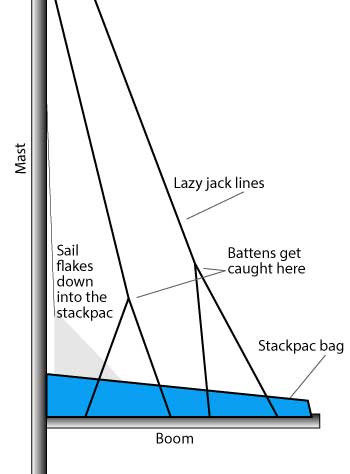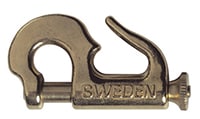
This article is an excerpt from NauticEd’s online Skipper Large Keelboats Course, a comprehensive online sailing course for beginner to intermediate sailors to learn how to sail large sailboats 26 ft (8m) and above. The Skipper Large Keelboats course is part of the Skipper Course Bundle of online courses, also teaching you how to master maneuvering under power and docking!
You can learn to sail and improve your sailing with NauticEd, the international leader in sailing education.
Unfurling or Raising the Sails
You have motored your vessel from the slip into open water and are now ready to either unfurl or raise the sails, depending on your setup. The procedures for deploying the sails are reasonably standardized, though every sailor will, over time, develop his or her own routine.
On modern sailboats, mainsails are commonly stored (“stowed”) either by being:
- Lowered and lashed onto the boom.
- Lowered into a stack pack (a long bag permanently mounted above the boom).
- Rolled into the mast (mast-furled mainsail).
- Rolled onto the boom (boom-furled mainsail).
- Removed and folded into a sail bag for stowage below.
Sailing is rife with opinions that add greatly to the excitement of this sport, and there are many opinions as to which is the preferred method, but for now, you will find that each has its pluses and minuses.
A Furled Mainsail
If a mainsail is rolled into the core of the mast it is called a “mast furled mainsail.” If it is stored rolled up into the core of the boom, it is called a “boom-furled mainsail.”
Unfurling: In preparation to unfurl the mainsail, head the vessel into the wind. Depending on wind conditions, you may wish to keep just enough speed, from the engine, to maintain steerage.
Just for fun, unfurl the mainsail from the mast now.
The mainsail is usually unfurled first. Unfurling is done by either raising the sail from out of the boom using the halyard or hauling the sail out from the mast using the outhaul.
The following steps provide a guide when the mainsail is furled in the mast:
- Motor into the wind maintaining steerage.
- Release mainsail furling inhaul line.
- Release tension on the boom vang and mainsheet (very important).
- Pull (haul) on the outhaul line—this brings the mainsail out of the mast along the boom.
- Tighten the mainsail against the boom by tensing the outhaul line. On light wind days, don’t tension the outhaul so much. Allow about 10 inches (26 cm) of draft. Draft is the distance that the sail curves out and away from the boom. On windy days, use more outhaul tension, say 4 inches (10 cm) of draft.
- Bear away to the desired heading and trim the mainsail with the mainsheet (the line/rope that brings in or lets out the boom)
A Good WhippingOnce when unfurling the mainsail, we didn’t keep the outhaul line taut. The clew of the mainsail started whipping violently, which prompted the outhaul block to break free and join in. A Doc-in-a-box visit later, my friend exited with five stitches to his face. Don’t let lines whip. People and things break! |
If you are unfurling the mainsail from the boom, first attach the halyard to the “head” of the sail and then raise the mainsail by hauling on the mainsail halyard.
Here is a video by Leisure Furl using a boom furling mainsail. It shows the boom furler in use as well as showing how to reef the boom furling mainsail while under sail.
Leisure Furl Boom Furling
Raising the Mainsail
Many boats these days still do not have an in-mast roller-furling mainsail and you must raise the sail up the mast by pulling on the main halyard. The luff (leading edge) of the sail will most likely fit into a track and thus will need guiding up. During this process, it’s important that the helmsman keep the boat facing directly into the wind. Any side force on the sails will make it very difficult to raise the sail. You can alleviate the force on the mainsail if you are not directly into the wind by further letting out the mainsheet. Be careful, though, because the boom will now “flog” (oscillate) from side to side with possible head injury consequences.
The helmsman is also responsible for keeping an eye on traffic and obstacles. It is easy to become distracted by the sail going up.
Just for fun, let’s raise the mainsail now.
Often the mainsail is stored in a stackpac, which is a long bag permanently mounted to the boom. Lazy jack lines extend from the mast down to the sides of the stackpac bag. The lazy jacks ensure the mainsail drops easily into the stackpac at the end of the sail. However, battens are always getting caught in the lazy jack line as you hoist the mainsail. Take care when hoisting and look aloft as the sail goes up.
Once the sail is all the way up, cleat off the halyard and tighten down on the cunningham if one is available. The amount of tension you put into the leading edge (luff) of the sail through the halyard or cunningham is proportional to the wind strength. Light winds require slight tension to keep the sail baggy and give it plenty of shape. High winds require high tension to reduce the curvature of the sail.

Stackpac
The outhaul is another line to help make the sail more efficient. The outhaul is the line that is attached to the clew (bottom aft connection point) of the sail. When you tighten this it flattens the sail against the boom. On high-wind days, you want to tighten the outhaul as much as possible to keep the sail flat thereby reducing the curvature and lift. Don’t worry about losing curvature, you already have an abundance of lift from the high wind; at this stage, you want to get rid of lift to reduce the heeling of the boat.
In low wind, loosen the outhaul to make the sail baggier and curvier thereby increasing the lift.
Halyard tension and outhaul adjustments also apply to in-mast roller-furled mainsails.
Turning Off the Engine
Before you switch off the engine, bear away from the wind and get the boat sailing so you have maneuverability. Once you are sailing you may turn off the engine. It is important to not have the engine on if the boat is heeling because the cooling water intake may be out of the water and the engine could overheat.
Sailing at last! Is this real freedom or what?
Setting a Course
Next, decide where you want to go. Select a destination, such as a compass heading, a scenic spot in the bay, a distant idyllic island, or maybe a channel marker. When this decision has been made, you will next unfurl/raise the head (jib or genoa) sail.
Unfurling the Headsail

The Headsail
Before starting to unfurl the headsail (aka the jib or the genoa), it is best to have the downwind jib sheet already wrapped 2 to 3 turns around its winch. Once the sail goes out, if the wind is strong, you will not be able to hold the sail by hand without the help of those wraps. If you forget this the first time, don’t worry – you will never forget again after you get massive rope burns on your hands from trying (and failing) to hold a line against the force of the wind.
Make certain the jib furling line is laid out so it can flow out without tangling. Now you simply pull (haul) on the downwind jib sheet to unfurl the headsail. As the headsail begins to fill with wind, it will want to unfurl rapidly by itself. Therefore, you should control this as well by wrapping the jib furling line around a winch or cleat to slow its rate. Uncontrolled furling lines create bird’s nests in the furling drum that you will regret. As a precaution, always check the furling drum after deploying the jib sail.
Be careful: More than often, the loose furling line laid out in the cockpit will tangle. The crew member hauling on the jib sheet must watch to make sure this does not occur. Otherwise, the crew member cranking the winch is just pulling against the furling system.

Headsail Furling Drum
Look AloftAn early sailing mentor would slap me on the back of the head (like Gibbs in NCIS) and pronounce: “Look aloft young man, look aloft.” It meant that I was not chasing every line its full length with my eyes as I winched in. Something was jammed and I wasn’t seeing it. Thwack! |
Furling the Headsail
You’ll find that if you head the boat downwind, furling the headsail will be much (much) easier. To furl the headsail, have one crew member slowly release the jib sheet while another crew member hauls in on the furling inhaul. Keep a slight ten- sion on the jib sheet so the headsail rolls reasonably tightly around the forestay. Often enough tension can be created by having the jib sheet wrap once around a winch as you pull in on the furling line.
Be careful also that the crew member hauling the furling line keeps an eye on the amount of line remaining in the furling drum. Otherwise, you will reach the limit of the line and continuous hauling can cause damage. For this reason, when using a winch on any furling line, if the tension gets high, start looking for the problem.
In some circumstances, you’ll need to drop a furling-type headsail to the deck for maintenance. This is simple because the luff of the sail usually contains a bolt rope that slides up into a track on a plastic extrusion, which is slid over the forestay. The sail will need to be unfurled. Simply release the headsail halyard and pull down on the leech of the sail. To raise the headsail back up again just guide the bolt rope into the track in the forestay extrusion and tension the halyard.
Raising the Headsail
Many boats do not have a roller-furling headsail. In this case, you’ll be raising the headsail up the forestay. The headsail is usually stowed neatly in a bag below decks. Depending on the wind you’ll want to select the appropriate size headsail. High winds dictate a smaller sail; low winds require a bigger sail.
The sails will be labeled with numbers #1, #2, or #3, with #1 the largest, usually the genoa; #3 is a jib sail for high wind conditions and #2 is for midrange wind conditions. (The larger the number the smaller the sail. Why?—Just is.)
The luff (leading edge) of a headsail often has “hanks,” which are small clips permanently attached around the bolt rope about every 2 to 3 feet (0.6 to 1 m). The opening slider of the hank will clip around the forestay as the headsail is hoisted.

A Hank
Prior to leaving the marina, you will want to prepare the headsail for deployment. First, lay the headsail out on the foredeck. Then, attach the headsail halyard to the head (top connection point) of the headsail, the tack of the headsail to a clip mounted at the base of the forestay, and then the clew of the headsail to the jib sheets. Run the jib sheets back through the appropriate fairleads that will guide the jib sheets back to the cockpit. You’ll need to know the bowline knot since this is the recommended knot for the jib sheet to attach to the clew. Now clip the hanks onto the forestay. Use sail ties to tie the sail down to the foredeck so that it is secure until you want to raise it once you are out in the bay.
After you have deployed the mainsail and the boat is sailing, untie the sail ties as another crew member pulls on the headsail halyard. Once this is complete it is advisable to move back to the cockpit as the flapping headsail and jib sheets can be very dangerous in high winds.
Finally, trim the leeward headsail sheet with the headsail sheet winch. There you have it—you’re now fully under sail.
Dousing the Headsail
To douse (bring down) the headsail at the end of your sail is also pretty simple. It is best to douse the headsail first. For roller furling headsails, bear away downwind since this will make furling far easier.
For headsails that you drop to the deck, turn on the engine and head up into the wind. This allows the headsail to drop to the deck and not into the water. Make sure you use sail ties again to tie the sail to the foredeck or lifelines to stop it from self-deploying.
Pay AttentionLeaving North Sound in the British Virgin Islands, we saved another sailboat from crashing by sounding five blasts on our horn. The inattentive helmsman had been watching the crew trying to get down a jammed mainsail instead of looking where he was headed – right onto Prickly Pear Reef. The helmsman’s job is to keep the boat clear of obstacles and traffic. |
Dousing the Mainsail
Dousing the mainsail is done by heading into the wind with the engine on. For furling systems, maintain a small amount of back pressure on the outhaul for mast furling or halyard for boom furling. This is essential so that the mainsail is rolled tightly around its core.
For sails that are lowered into a stackpac (long bag along the boom), there is not too much to do except help to flake the bolt rope from side to side as it lowers into the stackpac. Watch this quick video as a sail lowers into a stackpac.
Video of a Sail Dropping into a Stackpac
Many mainsails are lowered and tied along the mast, then a mainsail cover is zipped over the sail to protect it.
Watch this video of a mainsail being flaked along the boom.
Video of Flaking a Mainsail
You can learn more in the Skipper Course....
Knowledge and theory for longer distances and overnight sailing in diverse conditions. The Skipper Course is a comprehensive online sailing course for beginner to intermediate sailors wanting to learn how to sail larger sailboats 26ft to 56ft. Or upgrade to the Skipper Course Bundle of online courses to also master maneuvering under power and docking!
